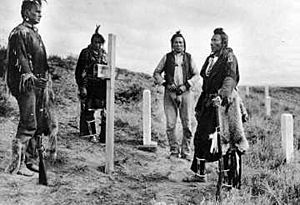Goes Ahead facts for kids
Quick facts for kids
Goes Ahead
|
|
|---|---|
| Bah-suk-ush | |

Goes Ahead Crow tribesman (c. 1910)
|
|
| Born | 1851 Near the Platte River
|
| Died | May 31, 1919 |
| Resting place | Little Bighorn Battlefield |
| Nationality | Crow Nation |
| Other names | First One, Goes First, the One Ahead, Comes Leading, Man With Fur Belt, and Walks Among the Stars |
| Spouse(s) | Pretty Shield, Pretty Shield's older sister |
| Children | Four girls and three boys with Pretty Shield |

Goes Ahead (born 1851 – died May 31, 1919) was a Crow scout. He worked with George Armstrong Custer’s 7th Cavalry during a major campaign in 1876. This campaign was against the Sioux and Northern Cheyenne tribes.
Goes Ahead was one of the few survivors of the famous Battle of the Little Bighorn. His stories and memories of the battle are very important. Historians today still use his accounts to understand what happened.
Contents
A Crow Scout's Life
Goes Ahead was born into the Crow tribe. He had many names, including the First One, Goes First, and Walks Among the Stars. When he was about 16 years old, he married a woman named Pretty Shield.
Joining the Army
Around April 1876, Goes Ahead volunteered to be a scout for the United States Army. The Crow tribe had a long history of being rivals with the Sioux and Northern Cheyenne. So, Goes Ahead joined the army to help fight against them.
On June 21, 1876, Goes Ahead and five other Crow scouts were sent with Custer's 7th Cavalry. Their job was to find a large Native American village. The scouts knew the area well, especially the Rosebud Creek and Little Bighorn River valleys.
Finding the Village
On June 24, the Crow scouts rode ahead of Custer's soldiers. They sent back a message that the large village they were tracking had moved. It was now heading towards the Little Bighorn valley.
Early on June 25, the day of the battle, the scouts were on a high hill. They could see signs of a very large Sioux and Cheyenne village about sixteen miles away. Goes Ahead and the other scouts warned Custer that the village was huge.
However, Custer had also heard that his soldiers had been spotted by warriors from the village. He worried that if he waited, the village would scatter. He wanted to attack right away.
The Battle of the Little Bighorn
Before the battle, Goes Ahead and the other scouts took off their army uniforms. They put on their traditional Crow clothes with eagle feathers. This was a custom to prepare for death and help their spirits.
When Custer saw this, he was angry. He thought they were giving up, so he dismissed them. Goes Ahead and the other scouts then joined Major Marcus Reno on a nearby ridge. Reno's group was attacked but managed to survive the fight.
Goes Ahead later told his wife, Pretty Shield, about what he saw. He said he was with Custer when Custer rode towards the Little Bighorn River. He saw Custer fall from his horse into the water. Goes Ahead said he was scared but did not run until he saw Custer fall.
Life After the Battle
After the Battle of the Little Bighorn, Goes Ahead lived on the Crow reservation. He and Pretty Shield raised their family there.
In the early 1900s, a historian and photographer named Edward S. Curtis interviewed Goes Ahead. Curtis wrote a book that helped people understand the battle better. However, some of Goes Ahead's more surprising stories were not shared until much later. Curtis's notes became public in the 1990s, many years after his death.
Goes Ahead passed away in 1919. He was buried in the military cemetery at the Little Bighorn Battlefield. His wife, Pretty Shield, later became an important source of information about the battle as well.

